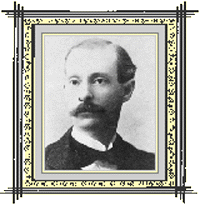This issue of The Indiana Historian examines the early years of public health science in the late nineteenth and early twentieth centuries.
Below on this page are a few suggestions about using this issue as a springboard for further investigation: "You be the historian."
On pages 3 and 4, there is a brief history of medicine and public health issues from a national perspective. The timeline throughout provides a broad context for the topic.
Indiana's efforts and progress in fighting disease and educating the public about health are reviewed on pages 5-7. Especially important was the creation of the Indiana State Board of Health in 1881.
Dr. John N. Hurty's leadership of the State Board of Health from 1896 to 1922 is reviewed on pages 8-9. Hurty's energetic and confrontational style in the war on disease is evident in some of the materials reproduced in this issue.

Dr. John N. Hurty in 1896.
Rice, 69.
On pages 10 and 11, the core problem of obtaining pure water is addressed. The drawing on the back cover relates to this topic.
Indiana's fight for healthy milk is briefly reviewed on page 12.
On page 13, the life and accomplishments of Dr. Harvey Washington Wiley are reviewed. Wiley was crucial in the passage of the first federal Pure Food and Drugs Act in 1906.
The present state of public health science is briefly considered on page 14.
Page 15 contains the bibliography and sampling of resources.
There are many difficult words in this issue. Have a dictionary on hand to help.
- Explore the public health history of your area-town or county, for example. Use county histories, newspapers, public records in the courthouse, cemetery records, etc. Create a timeline of that history.
- Select an important event or person in your public health history and make a marker-see page 13 of the issue-as a commemoration.
- Contact public health officials in your area and the Indiana Department of Health for resources to help understand more about public health issues today.
- Dr. John N. Hurty and the State Board of Health conducted public relations campaigns against health hazards using posters and other printed materials. Survey how such campaigns are conducted now; gather sample materials. Identify a current health hazard and produce a campaign to alert others.
- Investigate the water supply for your community. Arrange a tour of the water treatment facility and/or invite engineers to make a presentation in your classroom.
- Explore how your family and your community make sure your food is safe. Invite a teacher, nutritionist, extension agent, or other food-related professional to discuss food safety-and other food-related health issues.
- Explore how milk and other dairy products are produced and marketed today.
- Talk to older persons in your area. How was milk bottled and delivered ten, twenty, thirty, or forty years ago?
- What is pasteurization? Is it a process only for milk?
- Invite a physician, health care professional, or scientist to talk with your class about medical and scientific advances and challenges.
- Collection of "vital statistics" began in Indiana under Dr. Hurty. What are they? How are they collected? Why are they so important?
